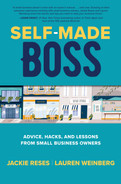
CHAPTER 9
Growth and Scale
Leilani Baugh has never been accused of thinking too small.
A product of Oakland, California, Leilani is a chef who is always cooking up new ideas. She learned Chinese cooking from one of her grandmothers and Southern cooking from the other. Back in 2011, she started selling dishes from both traditions to customers from her home. Two years later, she catered a birthday brunch for a former police commissioner in San Francisco. After that, demand grew and she set her eyes on forming a full-fledged catering company.
That wasn’t enough for Leilani. Six years later, she opened up two restaurants, Roux and Vine and the Magnolia Street Wine Lounge & Kitchen; she held residencies at Northern California wineries; and she put on pop-up events throughout the Bay Area. Now she’s writing a cookbook.
“I’ve recognized that this could be really big,” Leilani says. “I want restaurants, catering, and a cooking show. I also plan to do an incubator kitchen for women of color, where they can learn the business and culinary sides and leave with their own businesses. That’s the finish line.”

Leilani Baugh Leilani Baugh owns Roux and Vine, a restaurant in Oakland, CA. She grew up with a love of food, learning Southern cooking from her Black grandmother and Chinese cooking from her Chinese grandmother.
It’s an inspiring trajectory, and most business owners hope to achieve something like it one day themselves. But expanding your business doesn’t happen on its own. You’ve got to navigate questions of strategy, timing, and capacity. In this chapter, we’ll walk you through paths that can help you grow your business—on your terms.
![]()
Growing your business can be intellectually engaging, challenging, and fun. Do it successfully and it will probably be good for your bank account—and your mental health.
You might even create jobs for other people and make a bigger impact on your community as a whole. There are a host of benefits to growing your business. But before we get into the steps you’ll want to take to do just that, we want to be clear: Growing your business is a choice. You don’t have to do it.
It’s Okay to Stay Small
There is absolutely nothing wrong with running a business that stays about the same size, year after year. If it helps you pay your mortgage and gives you the flexibility you want in how you spend your time, it might be the perfect fit for your life. If it’s working for you, keep doing it. There’s no reason to change.
Here are a few reasons why you might decide to keep your business as-is.
You want to keep doing your current work. A goldsmith spends her days casting metal and setting gems. If she expands her shop by hiring more goldsmiths, she will inevitably trade some of the time she currently spends making jewelry for time spent supervising other makers. Doing what you love is more than enough reason to maintain the status quo.
You’re the only one who can do your work. An artist can hire people to market her work, prep her canvases, and talk to collectors. But she probably can’t pay another person to paint portraits for her.

Bobby Crocker Bobby Crocker owns LVLUP Fitness, a personalized training service in California’s Bay Area. He is an ex-professional baseball player.
You don’t want the problems that come with a bigger business. Even a successful bigger business can bring additional responsibilities. You may carry those responsibilities around with you even after you’ve left the office. “More money, more problems,” says Bobby Crocker, who owns LVLUP Fitness, a personalized training service. “If I opened up a string of training facilities, I would have huge amounts of stress. I work to live. I don’t live to work, though when I’m working, I’m all in.”
Your business model thrives on exclusivity. Sarah Korpela, who owns Luxury Estate Managers of Aspen in Colorado, says that her business thrives on scarcity. She’ll always keep her total number of properties at or below 35 houses. “I need to keep service to a very high standard, and that means staying small and specialized,” she says. “I want the company brand to remain boutique and high end, and that means bigger isn’t always better. It may not benefit my brand to grow if service and my standard is compromised.”

Sarah Korpela Sarah Korpela owns Luxury Estate Managers of Aspen in Aspen, CO. Her clients, she says, are able to treat their homes like five-star hotels: one call gets them whatever they need.
You want work-life balance. If you have caregiving responsibilities for your loved ones, or you simply prize the time you’re able to travel or spend with your friends and family far more than working, you might not want to put in the early mornings and late nights it takes to expand your business beyond its current state. As Bobby Crocker noted, there are people who live to work and people who work to live. If you’re the latter, and all of your needs are already met, consider keeping your business the same size it’s always been.
How to Grow Business Revenue
Virtually every business owner, however, would be happy to make more money.
SPECIALIST

Joey Rault Joey Rault is the head of sales at Orum, a fintech company building the technology for real-time payments. Joey’s work focuses on creating a better, more transparent and efficient financial infrastructure for businesses to thrive. Joey lives in NYC with his wife, Courtney.
“The number one thing every business owner wants to talk about is revenue and how to grow it,” says Joey Rault, a sales executive specializing in small businesses. “Business growth anchors on that revenue question.”
Small businesses can grow revenue through a variety of strategies, from raising prices to expanding licensing. The rest of this chapter explores ways to grow revenue and scale your business.
Test Pricing Up and Down
Boosting prices could plump your bottom line without adding to your workload. Joey suggests that you look at your numbers to determine your best products—and then consider how much, when, and to whom you’re selling them.
It might sound counterintuitive, but cutting prices can sometimes be the first step toward raising prices. “See how much more you sell if you offer a discount,” he says.
If you sell more when you offer a discount, it might make sense to keep the price lower. However, if you sell the same amount as usual, it stands to reason that you’re not going to suddenly bring in new customers because of the lower price tag. The best way for you to increase revenue may very well be by goosing your prices a bit.
Of course, you should test that hypothesis, too. If your sales numbers remain the same after you raise prices, keep the higher price. If they drop, you might want to lower them back to where you started. These types of tests help you understand the boundaries of this important lever—pricing.
It can always help to talk directly to your top customers about price. What would they like more of? How do your prices compare with your competitors? Is there a better structure for pricing that you hadn’t thought of? There is a lot to learn by listening to the feedback of those who buy your product or service.
Knock on All the Doors
Sometimes you have to push yourself out of your comfort zone.

Andrew Hypes Andrew Hypes is a DJ and producer based in Richmond, VA. He began playing the drums in the third grade.
Andrew Hypes used the same technique to get more gigs for his DJ business. “I found out who was in charge of hiring at clubs and bars, got in touch, explained who I am, and said, ‘You should hire me,’” says the Waynesboro, Virginia, native. This can be uncomfortable to do, particularly at the beginning, but you get used to putting yourself out there. If you don’t advocate for yourself, who will do it for you?
Expand by Brick and by Click
Moving your business to a new location or starting a second shop across town are obvious ways to expand your potential circle of customers. If you can afford to move to where there’s more foot traffic, you’ll probably see more customers. If your restaurant can fit a few more tables, you’ll seat more customers and run more tabs. Min Park, a restaurant group consultant and investor, likes having restaurants with multiple locations, in part for this very reason.

Min Park Min Park is an ex-finance professional (JPMorgan) who invests in hospitality concepts such as Rooster & Rice and Itria, technology, real estate, and cryptocurrency.
Expanding your presence doesn’t always mean making your physical space bigger—you can explore online sales, too.
SPECIALIST

David Rusenko David Rusenko is the general manager of e-commerce at Square in San Francisco, CA. He was the founder and CEO of Weebly.
“Two kinds of businesses sell online,” says Weebly founder David Rusenko. “Startups often choose to sell online before they sell in person, and established businesses also move from ‘brick’ to also having a ‘click’ presence. Maybe they’ve already done some Instagram and Etsy, and that leads naturally to setting up their own online order pages.”
Selling online can sometimes lead to exponential expansion. Build a hit product and sell it in a store, a craft fair, or farmers’ market, and your customer pool is limited to the people who happen to attend the market or walk in the door when you’re open. The internet never closes. Selling online means that you don’t have to make every sale face-to-face, and you don’t have to set business hours, either. If an order comes in at night while you’re asleep, you can just ship it the next morning.
“Buyers are increasingly shopping wherever and whenever is convenient for them,” David says. “The pandemic only intensified that trend.”
Avoid the Common Pitfalls of Selling Online
In considering online sales, many business owners think only of managing the transaction: accepting a credit card online and processing that payment. But selling online can be a lot more complicated. To do it well, you really should use a technological platform that helps you coordinate your operation.
This is particularly important if you’re selling both in person and online. Any shoe store, for example, has a limited number of shoes. You don’t want a situation in which a customer buys a size 9 pair of heels in the store when someone just clicked “buy” on that same pair online—especially if you don’t have a product inventory that includes more than one pair of that size 9.
The more ways you sell, the more complicated the problem can become, a challenge restaurants often confront. That’s because many dining establishments don’t just sell to in-house diners. They also deliver to people calling in on the phone, through their own website, and through food-delivery services like Grubhub, DoorDash, Instacart, or Postmates. That can lead to a backup in the kitchen if you’re not prepared to handle the rush.
Here’s how you can streamline these problems. The first, and most important, step is making sure you’re set up correctly on the technological front. That doesn’t mean you have to hire a new IT manager. Toast, Clover, PayPal, Square, and Shopify make platforms that can help you manage inventory that you’re selling through multiple avenues. These services offer ready-made systems that are easy to learn and effective at solving problems. They combine a digital point of sale with the ability to accept payments both online and offline. In the context of restaurants, Toast and Square, for example, offer an explicit workflow that helps manage the kitchen and keep track of orders coming in from online, delivery, and in-person diners. There are many options for systems, and it’s worth exploring whether there is one that’s specific to your industry. Shopify provides a platform for online sales and has broad functionality for getting up and running quickly with a professional ecommerce business. Look at the features and test it out.
Streamlining your sales channels is another strategic way to handle this problem, David says. This means you try to funnel the number of places people buy your product to as small a number as possible. For example, if you acquire customers on Etsy, shift them to a direct relationship via your company website as quickly as possible rather than continuing to sell to them through Etsy. This could mean following up with an email or including a coupon for exclusive products bought through your website when you deliver the initial purchase.
That said, be careful not to build too many platforms that are disconnected and hard to maintain. Think through a customer’s logic with simple examples of how you would buy things. As you re-create the customer journey, you will see the potential problems that arise with how you plan to build out the technology to support your business—and you will be able to identify solutions, too.
Build Relationships with Larger Retailers
Another option is to get someone else to sell your products, too.

Lisa O’Kelly Lisa O’Kelly is cofounder of Zellee Organic, based in Maui, HI. The company makes an organic, plant-based fruit jel snack that uses konjac, a plant from East Asia, to gel the product, instead of gelatin.
Hawaii-based Zellee started out selling its fruit-based jel snack online and at local grocery stores in Hawaii and California, where the company’s two founders live. Zellee co-owner Lisa O’Kelly said they were looking for more options to boost sales, so they started talking to natural food distributors.
To get a distributor, companies typically need to prove that there is already consumer demand for their product. In Zellee’s case, that meant collecting letters from local grocery stores that already carried their product and hiring a brokerage firm to send representatives to persuade new stores to stock Zellee.
Zellee also hired a consulting firm to get in front of bigger grocery stores, such as Whole Foods, Safeway, or Kroger, which have set category review schedules. The consulting firm explained how the system worked, then helped them pitch Whole Foods in Southern California at the appropriate time. Hiring the consultant was a little like hiring an agent, O’Kelly says. The consultant has relationships with decision makers at these larger stores, and clients benefit from those connections.
These new distribution relationships, made possible through hard work and investing in outside help, have allowed Zellee to boost sales. It’s an investment that’s paid off in partnerships with more than 100 new stores selling Zellee’s product.
The company’s next step is big-box stores, such as Target and Walmart. “Most large retailers would like you to buy advertising in their circulars and online platforms, as well as donate to their foundations. Some have slotting fees where you pay to be on the shelf, like renting shelf space,” Lisa says. Again, an investment like this could very well pay off, as long as you’re sure that once your product is available to customers, they will buy it.
Zellee currently runs distribution from a warehouse in Fresno, California, and also fulfills website orders out of Lisa’s garage. “We send out 15 to 20 packages a day, plus samples to retailers and influencers,” she says. Fulfillment will need to change when the company starts distributing with Target and Walmart, as volume will increase substantially, but that’s a problem that Lisa and cofounder Eriko Dowd are happy to have.
Sell Adjacent Products or Services
If you’re looking to grow, you might also think about expanding into new product lines. What other items and services do your customers already buy? Are you interested in providing anything on that list?

Keith Miller Keith and Patrycia Miller own Bubbly Paws Dog Wash in Minneapolis, MN. Keith sometimes brings his employees cupcakes.
In St. Paul, Minnesota, Bubbly Paws owner Keith Miller got into the dog-grooming business because he was already running a dog daycare. “People kept asking if their dogs could get clean at the daycare,” Keith says. “Our daycare space wasn’t big enough to add grooming, so we opened Bubbly Paws as a second business.”
This kind of expansion in verticals is an even better plan if you use it to distinguish your business from the competition. Heber Valley Milk & Artisan Cheese, located in Midway, Utah, was just a dairy farm before owner Russ Kohler adjusted its model. “We needed to do something different, and we hit on artisanal cheese,” he says. Unlike competitors who simply process and sell milk, Heber Valley makes and sells cheddar, Monterey jack, queso fresco, and a Finnish-style cheese called juustoleipä. Now the business is selling something unique, rather than just something that’s often considered a commodity. “It is hard to quantify how much my business actually grew, because it morphed into an entirely different business model, but I would say my revenue has gone up about 800 percent over what it was 10 years ago when we started,” Russ says.

Russ Kohler Russ Kohler is in the fourth generation of his family to run Heber Valley Milk & Artisan Cheese in Midway, UT. Adding artisanal cheese helped Heber Valley to stand out among area dairies.
Find a Partner
It might not be a forever solution, but if you want to dip your toes into a larger market, a partnership or trade might let you try on the experience and see if you like it. A partnership can add working capital, provide fresh ideas, bring new skills, offer a valuable trade, or just divide the labor of starting and running a small business.
When the growth of her business was just beginning to accelerate, Leilani Baugh began catering out of a space in a busy commercial kitchen. That gave her more room than she’d had in her kitchen, where she’d started out. But in order to use that space, she had to pay rent.
Leilani took the offer because it gave her access to a much less expensive kitchen from which she could fulfill her catering orders and let her provide customers with somewhere to sit and eat during her pop-ups. The arrangement lasted a year and couldn’t have been more successful. It gave Leilani a steady income as she was growing her business. “It also gave me an opportunity to see if owning a restaurant was really what I wanted to do,” she says.
Focus on Repeat Sales
Given a choice between a new customer and a repeat customer, you want a repeat every time. Why?
• Getting a new customer can cost five times more than retaining an existing customer. New customers need to discover who you are, where you are, and what you can do for them—all things you might have to spend marketing dollars to accomplish. Existing customers have all that information already.
• Existing customers are also between 3 and 12 times more likely to buy from you than new customers. They know your work and they’re already fans, so they don’t have the hesitations about whether they’ll be happy with a purchase that a new client might have.
Bobby Crocker is a good example of a business owner who has benefited from the power of repeat business. When injury ended his career as a professional baseball player, he decided to use his skills to train others. “I put an ad in the local paper and started getting clients right away,” he says. But there was a problem. Personalized training isn’t a product that enables consistency in scheduling.
So Bobby made a change. Rather than selling an hourly product, he switched to selling camps, video training, and team training. Now, he works with a variety of schools on youth fitness in addition to his one-on-one sessions—and his schedule is much more predictable.
Here’s the key: With this new model, most of his clients come back to him again and again, both for individual time and for their broader families. He’s lost the effort and expense of finding new customers—an especially draining process when every customer is a new customer—and gained a business in which most of his hours and time are driven by school and camp sign-ups.
Sell Other People’s Products
Erin Caudell co-owns The Local Grocer, a farm-to-shelf, community-based agriculture and specialty store in Flint, Michigan. Three days a week, she also sells her farm’s goods at a stand at Flint’s downtown farmer’s market. At both outlets, The Local Grocer supplements the food from its own farm with food produced by other people. “At the farmer’s market, we get elk and venison through a supplier, milk from an Amish dairy in northern Michigan, and fruit and locally produced pantry products from other suppliers,” Erin says.
Erin adds that her store has bought produce from perhaps 25 different farmers, which she says is especially useful for niche products like mushrooms. It’s sometimes difficult, though, to find vendors who will provide produce that doesn’t need a lot of washing or trimming. “It needs to be consistently nice, not hit and miss,” she says. “That’s a lot more labor, either time spent in technical assistance or at the sink, and it’s sometimes not worth the time.”

Erin Caudell Erin Caudell and her partner, Franklin Pleasant, co-own The Local Grocer in Flint, MI. They are longtime food activists and newer farmers, working to make sure every community has access to nutrient-dense foods.
That’s the key when you’re selling goods from other suppliers; you’ve got to price it right. Make sure to include the wholesale cost to you, as well as any labor and time costs, in the final price tag the customer sees. Only then can you be sure you’re making a sustainable profit.
Use a Subscription Model
The Local Grocer also sells community-supported agriculture, or CSA, shares for its farm. CSA shares are essentially a subscription plan in which consumers pay a single price for weekly shares of produce throughout the growing season. If a farm has a bumper crop, customers get the benefit of that. If conditions aren’t as good, their weekly shares are smaller.
“We built it up to about 40 families as CSA members, and then we teamed up with two other farms to make a CSA that sells food for 26 weeks a year to 125 members,” Erin says. Customers benefit because they know that they’ll get fresh food every week. The Local Grocer and its partner farms benefit because they’re able to presell their produce, often before putting seeds in the ground, giving much more certainty to their farming operations.
Subscription models can also work in a variety of other industries. Let’s say you make skincare products. You might invite customers to set up a subscription in which they get a new jar of hand cream every three months, while also giving them the option of buying one jar at a time. A restaurant could offer customers a flat monthly price for one delivered meal every week. These models allow for more stability in your month-to-month income—and allow you a greater ability to plan ahead for this more consistent demand.
License or Franchise Your Business Model
You can even grow your business by letting other people run it. This could take the form of licensing, where someone else pays you for permission to manufacture a product based on your intellectual property; or franchising, where another person pays you a fee plus ongoing royalties in return for use of your trademark, ongoing support, and the right to use your system of doing business while selling your product or service.
San Francisco’s Tutu School is an example of a successful franchise operation.
With multiple, constant stressors on their bodies, most ballet dancers have short careers. Genevieve Weeks knew that firsthand when she moved to San Francisco to dance with the Oakland Ballet—so it wasn’t long before she started thinking about what she would do when she retired from performing.

Genevieve Weeks A retired professional ballet dancer, Genevieve Weeks owns Tutu School, a franchised operation that offers ballet classes for toddlers and kids. She is based in Chicago, IL, and San Francisco, CA.
Tutu School, a ballet school for children, was the answer. It was the perfect way for Genevieve to continue her passion, and her paycheck.
“I opened the first school in San Francisco in 2008,” Genevieve says. “It was me and a tiny room on the edge of the North Beach neighborhood. There started to be an explosion in children’s services, coinciding with a baby boom of children entering toddlerhood in San Francisco. No one in the dance space had caught up with that.”
This all happened in the middle of one of the steepest economic downturns the country had ever seen. Even in a recession, Genevieve found, people still spend money on their children. With some luck and a whole lot of hard work, Tutu School was an immediate hit.
Genevieve soon hired another teacher. Then she started another Tutu School in Marin, where some of her kindergarten-age students had moved. A year later, Genevieve realized that Tutu School could thrive anywhere there are children. That’s when she began to think about franchising the business.
A friend, who had recently franchised her wedding apparel business, referred Genevieve to her franchise attorney. “It was intimidating when we first met with her to find out everything involved in franchising,” Genevieve says. The list included trademarking the logo, incorporating as an LLC for the two Bay Area locations, and establishing an S corporation for the franchising operation. (You can find more about legal structures for small businesses in Chapter 3, “Legal Matters.”)
Perhaps most important, she began systematizing everything about the business. Instead of registering dancers with a series of spreadsheets, she moved to using studio management software created specifically for the business. She created a more robust curriculum and training materials, instead of simply training teachers by having them follow her.
“Even if you have no intention of scaling through franchising, it’s useful to go through the exercise of considering how you’d run your own business,” Genevieve says. “There’s no downside to systematizing your business, really looking at your systems and operations.”
Do that earlier rather than later, she says. It will give you a sense of whether a business can be replicated. Plus, your existing business will run more smoothly.
Weeks’s little dance business has blossomed into 37 Tutu School locations, 34 of them franchises. Eight more are sold but not yet open, and 10 are reserved. The franchising relationship works well for both Genevieve and the independent operators. Franchisees pay both a purchase price and a royalty on gross sales.
Most franchisees operate multiple locations. Some of them, like Genevieve, are making a retirement plan for their post-dance lives. Others are past Tutu School parents who have corporate backgrounds and want a family-friendly, flexible business.
But while franchising her business has worked out well for the most part, Genevieve says there are also drawbacks. “I expected more passive income than I’m finding,” she says. “It’s a decent amount of work to support franchises.”
There’s a big difference between licensing a concept, which is more hands-off, and franchising, which is a true partnership. For example, on top of Genevieve’s hands-on support for franchisees, Tutu School uses an internal platform called Twirl to provide online training, documents, and a library of marketing pieces, such as print advertising and postcards. But for her, these steps are worth it.
“I was worried about being consistent across the brand, especially when we just had a few locations,” Genevieve says. With more locations, she feels that the company has actually given her business stronger communications around brand standards and provides better training and resources than it would if it were just the original school.
Plus, broader ownership means that more people have a stake in the business, and their suggestions come from wanting nothing but success for the company. Since she began franchising, ideas from franchisees have improved the business in countless ways—because what works in one market usually is worth adding across the board.
“No one has to reinvent the wheel, and the wheel keeps getting better,” Genevieve says.
Use Free Resources
As you’re looking to expand your business, take advantage of the wide variety of resources offering free advice.
Heber Valley, the milk and artisanal cheese seller, worked with Goldman Sachs’s free 10,000 Small Businesses program, which helped them create farm visit experiences that show off their products and processes. Owner Russ Kohler also spent time with an MBA class from a local university, which suggested different packaging. “They said that we should get away from a commodity look, so we stopped cutting our cheese in a block and changed the packaging,” Russ says.
When he worked with Utah’s Own, a Utah program that promotes in-state products, Russ also found a marketer and website developer—even though those services weren’t officially offered by the state.
And as we said in Chapter 1, don’t forget about the Small Business Administration! The SBA is set up to help you, from finding funding to connecting you with a business coach.
The honest truth is that starting a business is hard and expanding one can be even harder, which is why this work isn’t for everyone. But if you do want to grow your revenue, boost your sales, or expand your geographic footprint, there are plenty of options—and resources—available to help you do it.
Questions to Consider
• Who are some partners and resources in your industry or adjacent industries that might help you grow your business? Have you tapped them for advice?
• What other businesses might sell your products or services? What other products might you be willing to sell?
• Could you grow your business by finding a new audience online?
• Does your business lend itself to multiple locations or distribution outside your immediate geographical reach? How much of your business can you systematize?
• Would it make sense to expand your business through licensing or franchising? How replicable is what you’re doing?
